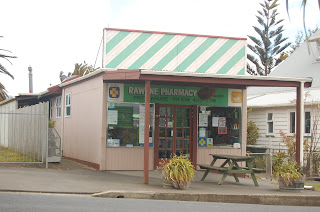This is possibly the remotest Mission house in the country, but boy does it have some views!
Overlooking the Hokianga Harbour, Mangungu (pronounced Mung..nunu, the 'g' is a very guttural sound but my pronunciation is shocking) was established in 1828 as the second Wesleyan Mission in New Zealand, under the protection of the Ngapuhi chief, Eruera Maihi Patuone.
The house was built in 1838-39 for the Rev. Nathaniel Turner, who, I think came from Scotland, but don't take my word on it.
Mangnungu saw the introduction of the honey bee to New Zealand and also played it's part in the signing of the Treaty of Waitangi in 1840; an agreement between the English Crown and 540 Maori tribes on the distribution and power of land. The day it was signed, 6 February, is now a national holiday in New Zealand.
Indeed, within the house is the actual table in which the Treaty was signed by the above in front of 3000 people, both Pakeha (Europeans) and Maori.
The house itself follows the symmetrical Georgian style that was popular within Britain during the first half of the 1800s and is made from local kauri. The Kauri tree is one of the largest and, now, most sacred within NZ. Many are named and preserved through the Department of Conservation as they were cut down to near extinction due to their strength and size.
The building is architecturally significant for depicting early 19th C timber-framed construction techniques, and is one of only a few surviving structures in the country that pre-dates New Zealand's establishment as a British colony. However, it is in rather a bad state. The house is suffering badly from damp and daylight can be seen through both the floorboards and roof throughout the house. A lot of work is needed to bring it back to its former self.
The house was actually moved, as a whole, in the 1970s down to Auckland and back again. A round trip of about 700km, so maybe on second-thoughts it is doing quite well!
It's position certainly makes you wonder how those coming over on the ships from Europe would have found life in New Zealand in the early years, despite the easy access to the best fishing grounds in the north. My boss told me a story concerning inter-tribal wars between the Maori, and I have to say I do not envy the first Pakeha who came over:
Land disputes were common between Maori and there is one story of a new tribe who came up from the south and sheltered in a cave at the top of a mountain not far from here. The resident tribe, understandably, did not like the idea of new-comers and, knowing the land better than them, smoked them out of the cave in the darkness and slaughtered them and.........ate them.
I can promise you, this does not happen any more and the residents are extremely nice and friendly!!
If you are up this way, it is certainly worth a look to take in the views and the history of the place. There is even an excellent pub 1km away that does cold beer and hot coffee. What more could you want?





























.JPG)
.JPG)
.JPG)
.JPG)

.JPG)
.JPG)
.JPG)
.JPG)

.JPG)
.JPG)
.JPG)







